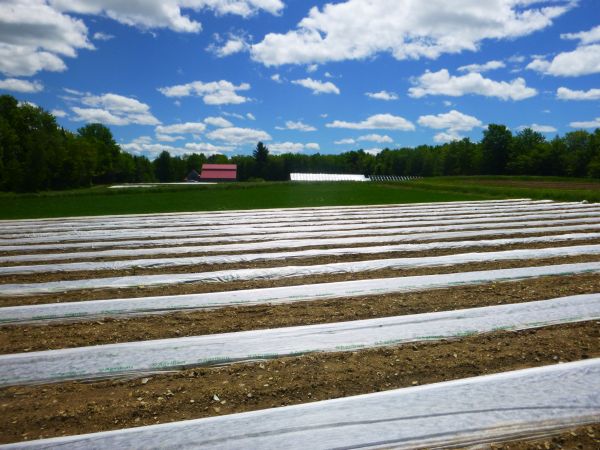How To Grow A Great Organic Garden
Gardening is fun and relaxing… that’s why so many of us do it, right?!
It's the same reason we love farming!
But let’s face the facts, like most things, if a little thoughtful planning goes into it, it usually goes much better!
That’s certainly been true for us over the past 14 years of running our own farm.
Here are our top tips and tricks that we’ve learned along our way of organic gardening that can help you make the most out of yours!

How to grow a great organic garden
Tip #1: Don’t plant too early! I promise it’s worth waiting!
When to plant what in Central Maine
There are two steps to the "not planting too early" thing:
- Don’t plant your seedlings before they’re ready to be planted (aka hardened off):
Harden off seedlings before planting outdoors. The process of gradually adapting young plants to increased light, wind, colder temperatures and less frequent watering will help them transition more successfully into the “real world.” Skipping this step can result in seedlings experiencing transplant shock and a greater possibility of seedling failure.
How to harden off: Bring plants outside for 2-3 days of mild weather before planting them so they can get used to the direct sun, wind and outdoor temperatures while still in their pots with their roots undisturbed.
- And don’t plant your seeds and plants in the garden until the soil is warmed up enough and the outdoor temperatures are favorable.
Anecdote: Farmers we know have early ground in southern central Maine and one year they were able to plant their peas in March due to a warm spell. The peas did germinate and grow (luckily), but they did not come in but a couple days earlier than peas planted many weeks later (at the normal time).
We know from our experience that planting seeds or plants when the soil is not yet warm enough can result in the seeds rotting in the ground rather than coming up and the plants suffering “cold shock” and "damping off" or dying as seedlings. Plus the stuff just grows at practically the same rate, so there’s no point in pushing it! It just gives the weeds and pests more time to compete :)
And here are our farm’s personal planting dates for classic garden crops:
| Vegetable |
Direct seed (DS) or transplant (TP)? |
Suggested planting dates |
|---|---|---|
| Basil | TP | June 1-July 1 |
|
beans |
DS | June 1-July 15 |
| beets | DS | May 20-July 15 |
| Bok choy | TP | May 20-Aug 15 |
| broccoli | TP |
May 20-July 15 |
| cabbage | TP | May 20-July 1 |
| carrots | DS | May 10-July 1 |
| cauliflower | TP | May 20-July 1 |
| cilantro | DS | May 20-August 1 |
| collard greens | TP | May 20-August 1 |
| cucumbers | TP or DS | June 1-July 1 |
| eggplant | TP | June 1 |
| kale | TP | May 20-August 1 |
| kohlrabi | TP | May 20-July 1 |
| lettuce | TP | May 20-Sept 1 |
| peppers | TP | June 1 |
| spinach | TP | May 20-August 1 |
|
summer squash/Zucchini/Winter Squash |
TP or DS | June 1 |
| Tomatoes | TP | June 1 |
For more info, check out this link to the UMaine Extension’s planting chart.
Tip #2: Plant spacing is key to success!
How much space to give each plant
We've learned that the amount of space that you give your plants can have a big effect on how much yield they give you and what quality of food you end up with. Anyone ever planted their carrots too close and only gotten tiny roots without much to eat? Same goes for just about everything!
| vegetable |
plant spacing recommended |
notes |
|---|---|---|
| basil | plant 12" apart | pick regularly to prevent flowering |
| beans/peas | thin to plants 2-4" apart | |
| beets | thin to plants 3-4" apart | |
| bok choy | plant 8" apart for medium heads | |
| broccoli | plant 10-12" apart | |
| cabbage | plant 12" apart | |
| carrots | thin to plants 1-2" apart | |
| cauliflower | plant 12-16" apart | |
| cilantro | thin to plants 4-6" apart | |
| collard greens | plant 12" apart | plant closer if you want to cut and come again smaller leaves |
| cucumbers | plant in hills of 2-3 plants, 36-48" apart | |
| eggplant | plant 12" apart | |
| kale/Swiss chard | plant 12" apart for full size leaves for bunching | plant closer if you want to cut and come again smaller leaves |
| kohlrabi | plant 8" apart | |
| lettuce | plant 8-12" apart for full size heads | plant closer if you want to cut and come again smaller leaves |
| peppers | plant 12" apart | |
| spinach | plants 6-8" apart | |
|
summer squash/ zucchini/winter squash |
plant in hills of 2-3 plants, 48" apart | |
| tomatoes | plant 24" apart | provide support |
For more info, check out this link to the UMaine Extension’s planting chart.
Tip #3: Use floating row cover to deal with pests organically
"How do you deal with pests on your organic farm?"
This is a common question that we get. The answer is row cover!
Have you seen it before?
It’s a white fabric that lets in air, light, sunlight, and rainwater, but excludes pests big and small. You completely cover the plants and they grow under it.
And it works!
Here’s a list of crops that it can help exclude pests from:
- Potatoes
- Kale
- Cabbage
- Broccoli
- Collard Greens
- Bok Choy/other Asian greens
- Summer squash
- Winter squash
- Cucumbers
- Watermelons
- Eggplant
How to apply row cover to your crops:
- Apply at planting time, either direct seeding or transplanting.
- Drape the fabric over the plants or seeds.
- Figure out a method for holding the fabric in place. You can cover the edges with soil, use sandbags, use firewood or other scrap wood, cinder blocks, etc.
- Yes, it is okay if it touches the plants. They can handle it.
- If you are growing a crop that doesn't need pollination, then you can leave it on until you harvest it (getting under to weed in the meantime of course). If you are growing a crop that needs pollination to set fruit (like tomatoes, cukes, eggplant, peppers, squash, etc.) then when the plant begins to flower, remove the row cover and keep it off. The pests will then descend, but the plants will be big enough to handle their damage without being destroyed. It works, I promise, as this is what we do!
- You can reuse the row cover year after year as long as you take care of it and don't tear holes in it.
Tip #4: Know when and how to weed to save your back and your time
Weeding is not your favorite, I'm guessing? Really, if you do a lot of it, it's nobody's favorite!
One way we get away with growing 7+ acres of organic vegetables with 5 full time farmers and some part time help is timely weeding!
Our tip is weed before you see weeds! This is the best tip I can give you and it will ironically save you the most time and backache. The second thing is, check out some small scale gardening/farming tools that allow you to weed standing up, rather than on your hands and knees. Like these standing hoes that we use on our farm.

How to weed using stand up tools:
- Make sure you pick a day that is sunny and bright (not raining) as weeds will not die when there is moisture to keep them alive.
- Take your stand up tool and push and pull it through the soil at a shallow depth to "scratch it up" and disturb any small plants growing there. If you wait until you can see weeds that are inches tall, this technique will not work! Remember weed when you don't think you need to, then it will be fast and easy, rather than hands and knees!
- Leave the small weeds that you disturbed on the surface of the soil to desiccate and dry up in the sunshine. They will not regrow!
- Repeat until your crop is big enough to shade out the competition.
Tip #5: You can eat the MOST diversity of veggies when you do a CSA AND a garden!
What to plant if you’re a CSA member
Because YES! We have lots of members who are also gardeners! And it’s actually a great way to go, because let’s face it, planting a couple few heads of lettuce every week to have fresh lettuce heads reliably through the whole season is very challenging in a home gardening situation. For us we can much more economically plant a long bed with hundreds of heads of lettuce that will be ready every week for our members!
Or maybe you have a favorite kind of tomato that you want to grow to snack on...
If you’re a gardener AND a CSA member (or interested in doing a CSA), check out this blog post I wrote for you on what to plant in your garden!




Add new comment